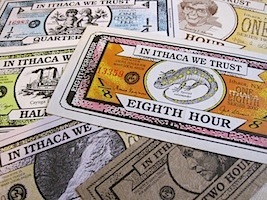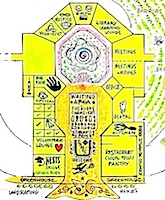




 |
 |
 |
 |
 |
| PAUL GLOVER ESSAYS: community
control of food, fuel, housing, health care,
planning, education, finance. |
| HOME | INTRO | CURRENCY | SUCCESSES | HOW-TO BOOK | PUBLICITY | ESSAYS |
| Big
Box Development: From Southwest Park to Southwest Pork May 2001 by Paul Glover City Hall has long preferred to pave Ithaca for more money, rather than preserve Ithaca for more generations. Some residents are pleased that City Council now moves like a bulldozer in high gear, spreading concrete and calling it economic growth, but they may be surprised to discover that the 160-acre Southwest development plan pushed by this Council will cause higher taxes, higher trash fees, higher water rates, public health hazards and worse traffic than ever. The $300,000 Draft Generic Environmental Impact Statement (dGEIS) for Southwest "Park" says so. Foremost among public health hazards, the dGEIS repeatedly emphasizes that paving or building atop the former 50-acre dump (1950-1970), which is venting methane gas, could cause parking lots to explode and shoppers to asphyxiate (vents and porous paving are suggested, without guarantee) (2.4.4; 2.4.5; ES-3). The dGEIS also expects that there will be more traffic accidents with more cars, of course, which diverts emergency vehicles from neighborhoods, and is more hazardous to pedestrians (T-12). The study's traffic section makes clear that traffic will degrade at 12 of 27 intersections studied, even if expensive new bridges and turning lanes are installed: "Improvements to the highway system are required to accommodate growth in traffic. However, widening existing roads and building new roads cannot address all needs and may cause other adverse community impacts" (T-20). For example, traffic at Meadow Street northbound would increase 25% (T2-19). Traffic on South Albany Street would increase from about 7,500 cars daily to over 16,000 cars daily. These dozen bottlenecks would surround the new roadways within the new shopping district, which become plumbing that will not flush. Traffic would overflow instead throughout residential streets. Essential "traffic calming" measures such as converting Plain Street from a residential street to an arterial (with bridge at Titus), is an example of this overflow. Traffic will worsen at Rte 13/Fulton/Clinton despite adding two lanes to the Six Mile Creek Bridge ($324,000 for LOS D). Another tentacle is restored to the Octopus, at Bridley Street. And the Turner/Clinton intersection would fail entirely, even with improvements (table T2-17). School crossings will be affected by added traffic (2.7.4: 2-49). Will the School Board evaluate this? The City's greater firefighting responsibility, to protect 1,000,000 more square feet of new tax base, may divert firetrucks from neighborhoods. Reduced water quality and reduced water pressure are also possible (2.9.1-3). Water and sewer rates will rise. Loss of water capacity due to diversion to Southwest will require the City to "develop capital improvement plans and supportive utility rate structures." The resulting "increasing costs due to higher flow rates" will require the City to "reevaluate rates" (vol. 1; 2.9.3 table 2-23). Although the consultants expect the project to cost taxpayers about $10,000,000 to construct (roads, bridges, sewer, electric, drainage), plus maintenance costs of $150,000 yearly for five extra police officers and $109,000/year for maintenance of 2.6 miles of new road (J:VI-2), they expect a net profit for the City of $1.7 million yearly (5% of City budget) for the largest of six alternative plans (Alt 3) which least risks shoppers' lives and least congests traffic (Appendix A Summary). This profit assumes that the area is built and shopped to full capacity, and does not consider that the City's Carpenter Industrial Park had been vacant for over 15 years. Yet the dGEIS does not include costs for the following: |
The consultants concluded, of course, that Southwest "Park" would "bring substantial new fiscal revenue to the City and the County, with the estimation by City officials that there will be relatively low additional service provision costs" (J:VII: Summary). Consultants conclude, every time, what they're paid to conclude. But based on this report, reasonable persons may be concerned that Southwest development might not benefit the general public so much as certain investors, contractors, advertising media, and City Hall bureaucracies. Government could prove its confidence that Southwest development would carry its own weight, however, by signing a contract with taxpayers not to raise tax rates for the next twenty years. City Council is sponsoring the greatest business intervention in the City's history, to profit these groups. This is called 'socialism for the rich.' Meanwhile, Council has resisted disturbance of the 'free market' by avoiding resolutions designed to protect Ithacans who would work there (diverse hiring, livable wage). Many Americans have One Idea of Progress, and that's the vision of more cars on new roads, endless novelty products made of exotic chemicals, more sales in larger stores, more buildings displacing nature. Their careers and identities are bound to it. They feel this dynamism defines the United States as the best country in the world, even more than the Bill of Rights. However, it's clear to many others that mere consumer progress has been destroying America's cities and our greater wealth of forests, fertile soils, clean water, and neighborhoods. Smart Growth advocates have pushed for progress more based on creating than mass consuming. This progress organizes the strength of each community-- our unique local enterprises, our talents, landscape, architecture, agriculture, regional raw materials-- to build networks that meet our needs securely and with dignity. The smart growth movement is represented by hundreds of organizations, by dozens of magazines, by thousands of websites (smartgrowth.org), by hundreds of proven practical models. Ithaca is rare among cities this size because it is still reasonably friendly and walkable. We and our children will prosper here by pioneering new development styles, rather than by becoming another victim of failed urban policy. There is no need to pave ourselves to save ourselves. |
| HOME | INTRO | CURRENCY | SUCCESSES | HOW-TO BOOK | PUBLICITY | ESSAYS |
 |